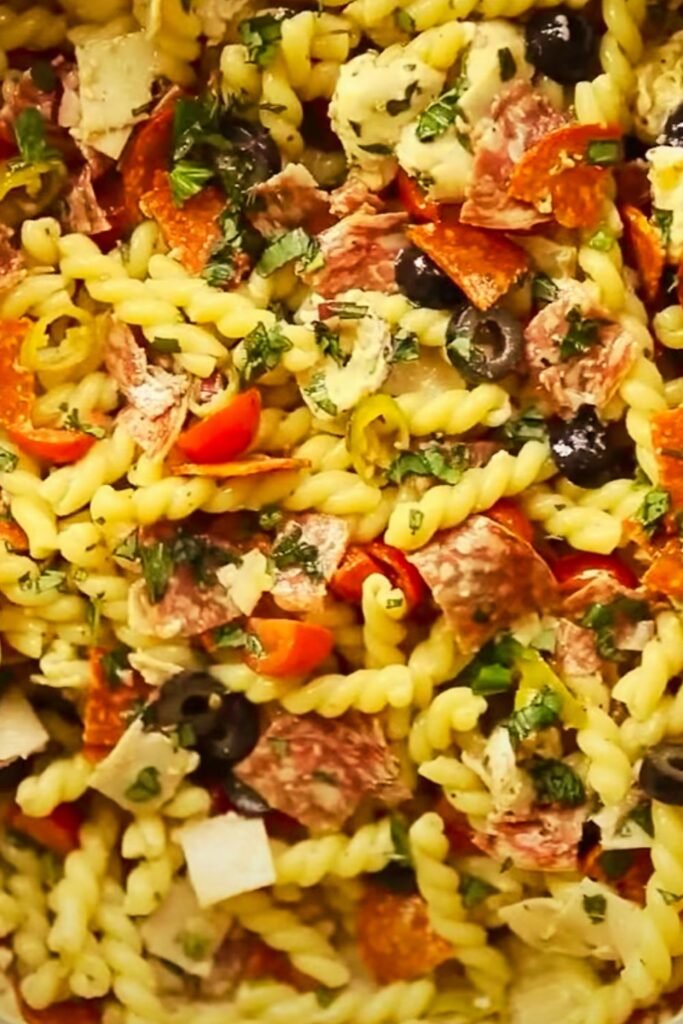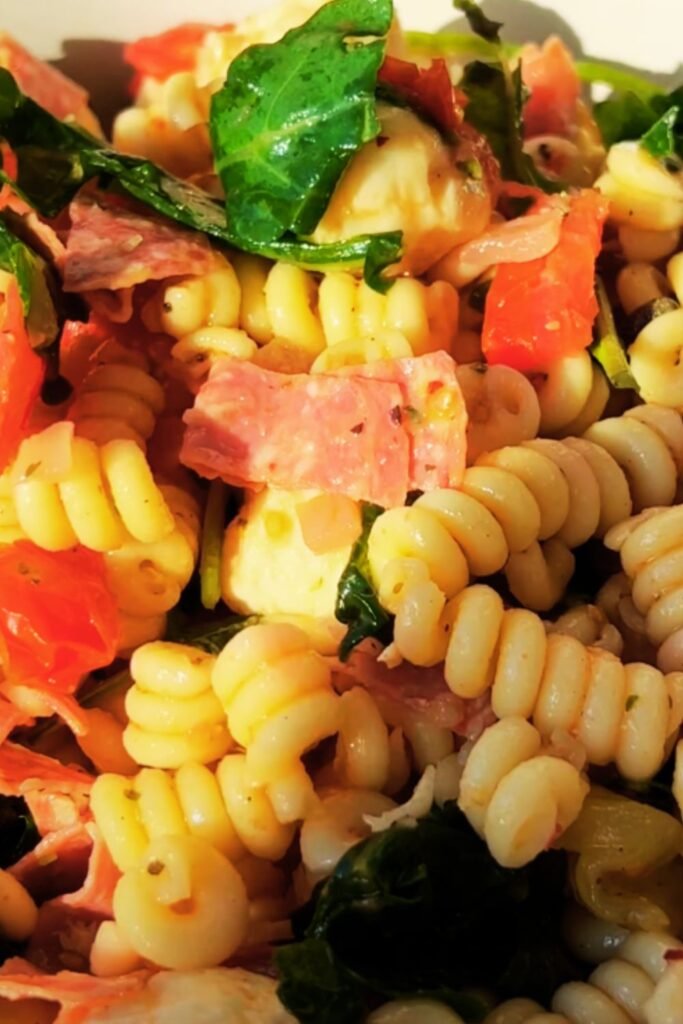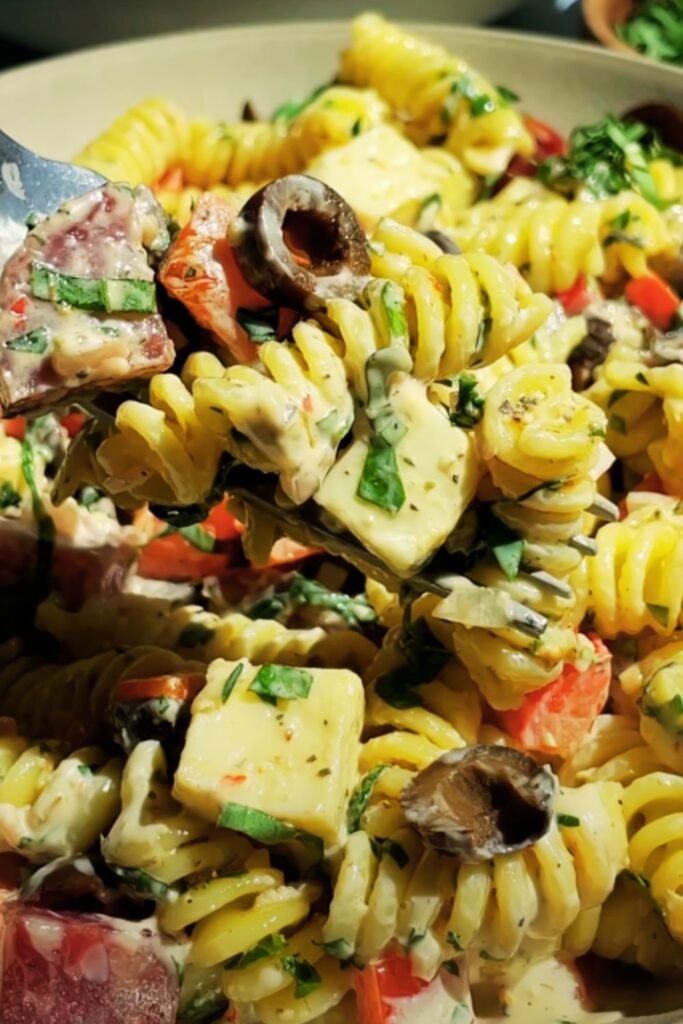There’s something absolutely magical about a perfectly crafted pasta salad that brings together the vibrant flavors of Italy in one incredible bowl. I’ve been perfecting my loaded Italian pasta salad recipe for years, and I can honestly say this version has become my go-to dish for every gathering, potluck, and family dinner.
This isn’t your average pasta salad – it’s a flavor-packed masterpiece that combines tender pasta with an abundance of Italian meats, cheeses, fresh vegetables, and a zesty homemade dressing that ties everything together beautifully. What makes this salad truly “loaded” is the generous portions of premium ingredients that create layers of taste and texture in every single bite.
What Makes This Italian Pasta Salad Special
My loaded Italian pasta salad stands out because of its perfect balance of flavors and textures. I use a combination of three different Italian meats, two types of cheese, and a medley of fresh vegetables that create a symphony of tastes reminiscent of a classic Italian antipasto platter.
The secret lies in the quality of ingredients and the technique I use to bring them together. Each component is carefully selected and prepared to complement the others, resulting in a dish that’s both satisfying and sophisticated.
Key Components That Define “Loaded”
Italian Meats: I include salami, pepperoni, and prosciutto for a trio of savory flavors that provide protein and authentic Italian taste.
Cheese Varieties: Fresh mozzarella balls and aged Parmesan create creamy and sharp flavor profiles that balance beautifully.
Fresh Vegetables: Cherry tomatoes, red onions, bell peppers, and olives add crunch, color, and Mediterranean flair.
Herbs and Aromatics: Fresh basil, oregano, and garlic elevate the entire dish with aromatic complexity.
Signature Dressing: My homemade Italian vinaigrette brings all components together with the perfect balance of acidity and richness.
Essential Ingredients Breakdown
Let me walk you through each ingredient and why I choose them specifically for this loaded pasta salad. Understanding the role of each component will help you create the most flavorful version possible.
Pasta Selection
I always use rotini or fusilli pasta because their spiral shape holds the dressing beautifully and captures small pieces of ingredients in every bite. The curves and ridges create perfect pockets for the flavors to nestle into, ensuring each forkful is perfectly balanced.
Alternative pasta options:
- Penne rigate
- Farfalle (bow-ties)
- Cavatappi
- Gemelli
The Italian Meat Trio
Genoa Salami: This provides a robust, garlicky flavor that’s quintessentially Italian. I dice it into bite-sized pieces that distribute evenly throughout the salad.
Pepperoni: Adds a slightly spicy kick and familiar pizza-like flavor that appeals to all ages. The oils from pepperoni also contribute to the overall richness.
Prosciutto: This delicate, salty ham brings an elegant touch and melts slightly when mixed with warm pasta, creating silky flavor threads.

Cheese Components
Fresh Mozzarella: I use small mozzarella balls (bocconcini) or dice larger balls into uniform pieces. They provide creamy texture and mild flavor that doesn’t overpower other ingredients.
Parmigiano-Reggiano: Freshly grated Parmesan adds sharp, nutty notes and a slightly granular texture that enhances the overall mouthfeel.
Vegetable Medley
Cherry Tomatoes: I halve these to release their juices, which mix with the dressing to create additional flavor. Choose firm, ripe tomatoes for the best taste.
Red Bell Peppers: These add sweetness and crunch. I remove all seeds and white pith for the cleanest flavor.
Red Onion: Thinly sliced red onion provides sharp contrast and beautiful color. I often soak the slices in cold water for 10 minutes to mellow the bite.
Kalamata Olives: Their briny, complex flavor is essential for authentic Mediterranean taste. I pit and halve them for easier eating.
Black Olives: These provide a milder olive flavor and darker color contrast.
The Perfect Italian Dressing
My homemade Italian dressing is what truly makes this pasta salad exceptional. Store-bought dressings simply can’t compare to the bright, fresh flavors you achieve when making your own.
Dressing Ingredients
| Ingredient | Amount | Purpose |
|---|---|---|
| Extra Virgin Olive Oil | ¾ cup | Base fat, carries flavors |
| Red Wine Vinegar | ¼ cup | Acidity, brightness |
| Fresh Lemon Juice | 2 tablespoons | Additional acidity, freshness |
| Dijon Mustard | 1 tablespoon | Emulsifier, tang |
| Garlic | 3 cloves, minced | Aromatic base |
| Italian Seasoning | 1 tablespoon | Herb complexity |
| Salt | 1 teaspoon | Flavor enhancement |
| Black Pepper | ½ teaspoon | Heat, depth |
| Sugar | 1 teaspoon | Balance acidity |
Dressing Preparation Technique
I whisk the vinegar, lemon juice, mustard, minced garlic, and seasonings together first, then slowly stream in the olive oil while whisking constantly. This creates a proper emulsion that won’t separate as quickly and coats all ingredients evenly.
The key is to taste and adjust. Sometimes I add a pinch more sugar if the tomatoes are particularly acidic, or extra lemon juice if I want more brightness.
Step-by-Step Preparation Guide
Creating the perfect loaded Italian pasta salad requires attention to timing and technique. Here’s my proven method that ensures every component maintains its optimal texture and flavor.

Phase One: Pasta Preparation
- Boil the Pasta: I bring a large pot of heavily salted water to a rolling boil. The water should taste like seawater – this is your only chance to season the pasta itself.
- Cook to Al Dente: Follow package directions but test 1-2 minutes early. The pasta should have a slight bite since it will continue to absorb flavors and soften slightly.
- Shock and Drain: I drain the pasta and immediately rinse with cold water to stop the cooking process. This prevents mushiness and helps the pasta hold its shape.
- Oil Lightly: While still warm, I toss the pasta with a tablespoon of olive oil to prevent sticking.
Phase Two: Ingredient Preparation
Meat Preparation: I dice all meats into uniform ¼-inch pieces. This ensures even distribution and prevents any single bite from being overwhelmed by one flavor.
Cheese Preparation: Mozzarella gets cut into bite-sized pieces, while Parmesan is freshly grated using the finest holes on my box grater.
Vegetable Preparation: All vegetables are cut to similar sizes for visual appeal and balanced bites. I remove seeds from peppers and tomatoes to prevent excess moisture.
Phase Three: Assembly Process
- Combine Base Ingredients: In my largest mixing bowl, I combine the cooled pasta with meats and cheeses first.
- Add Vegetables: I fold in the prepared vegetables gently to avoid crushing delicate items like tomatoes.
- Dress the Salad: I pour the dressing over everything and use large spoons to fold and toss until every component is well-coated.
- Initial Rest: The salad gets covered and refrigerated for at least 30 minutes to allow flavors to meld.
Advanced Tips for Perfect Results
After years of making this recipe, I’ve discovered several techniques that elevate the final result from good to absolutely spectacular.
Temperature Management
Room Temperature Assembly: I always let refrigerated ingredients come closer to room temperature before mixing. Cold ingredients don’t absorb flavors as readily.
Dressing Temperature: I make my dressing at room temperature and let it sit for 15 minutes before using, allowing the garlic and herbs to bloom.
Flavor Development Techniques
Salt Timing: I salt the tomatoes lightly and let them drain in a colander for 15 minutes before adding to the salad. This prevents excess water from diluting the dressing.
Herb Timing: Fresh basil gets added just before serving to prevent blackening and maintain its bright flavor.
Marination Strategy: I often make this salad a day ahead, holding back the fresh herbs and half the cheese to add just before serving.
Texture Optimization
| Component | Technique | Result |
|---|---|---|
| Pasta | Cook 1 minute under al dente | Maintains firmness after dressing |
| Mozzarella | Add half during assembly, half before serving | Prevents complete breakdown |
| Vegetables | Cut uniformly, salt tomatoes separately | Even distribution, controlled moisture |
| Meats | Dice consistently, bring to room temp | Better flavor integration |
Nutritional Benefits and Information
This loaded Italian pasta salad isn’t just delicious – it’s also surprisingly nutritious when you consider the quality ingredients involved.
Nutritional Breakdown (Per Serving)
| Nutrient | Amount | % Daily Value |
|---|---|---|
| Calories | 485 | 24% |
| Protein | 18g | 36% |
| Carbohydrates | 42g | 14% |
| Fat | 26g | 40% |
| Fiber | 3g | 12% |
| Sodium | 890mg | 39% |
| Calcium | 185mg | 18% |
| Iron | 2.1mg | 12% |
Health Benefits
Protein Power: The combination of meats and cheeses provides complete proteins essential for muscle maintenance and energy.
Healthy Fats: Olive oil and cheese contribute monounsaturated fats that support heart health.
Antioxidants: Tomatoes provide lycopene, while bell peppers offer vitamin C and carotenoids.
Probiotics: High-quality aged cheeses contain beneficial bacteria that support digestive health.
Serving Suggestions and Occasions
My loaded Italian pasta salad is incredibly versatile and works beautifully in numerous settings and alongside various dishes.
Perfect Occasions
Summer Gatherings: This salad shines at barbecues, picnics, and outdoor parties because it’s served cold and actually improves with time.
Holiday Meals: I often serve this alongside traditional holiday dishes as a fresh, light counterpoint to heavier foods.
Potluck Events: It’s always a crowd-pleaser and travels well, making it ideal for sharing.
Meal Prep: The salad keeps excellently for several days, making it perfect for weekly meal preparation.
Complementary Dishes
Grilled Proteins: Pairs wonderfully with grilled chicken, fish, or vegetables.
Crusty Bread: Italian bread or focaccia makes an excellent accompaniment.
Fresh Fruit: Seasonal fruits provide a refreshing contrast to the rich, savory flavors.
Light Soups: Works well alongside minestrone or tomato-based soups for a complete Italian-inspired meal.
Storage and Make-Ahead Tips
One of the best features of this pasta salad is how well it keeps and actually improves with proper storage.

Optimal Storage Method
I store the salad in airtight containers in the refrigerator, where it maintains peak quality for 3-4 days. The flavors continue to develop and meld during this time, often making day-two salad even better than fresh.
Make-Ahead Strategy
Full Assembly: I can make the complete salad up to 2 days ahead, reserving fresh basil and a portion of the cheese to add just before serving.
Component Prep: All individual components can be prepared separately up to 3 days in advance and assembled the day of serving.
Dressing Preparation: The dressing actually improves when made ahead, so I often prepare it 2-3 days early.
Refreshing Leftovers
Additional Dressing: Sometimes I add a splash of fresh lemon juice or a drizzle of olive oil to refresh day-old salad.
Fresh Herbs: Adding fresh basil or parsley to leftover salad instantly brightens the flavors.
Temperature Adjustment: I let refrigerated salad sit at room temperature for 15-20 minutes before serving to optimize flavors.
Variations and Customizations
While my base recipe is perfect as-is, I love experimenting with variations that cater to different tastes and dietary needs.
Protein Variations
Seafood Version: I sometimes substitute Italian tuna, anchovies, or cooked shrimp for the traditional meats.
Vegetarian Option: Marinated artichoke hearts, sun-dried tomatoes, and extra cheese create a satisfying meat-free version.
Lighter Version: Using turkey-based Italian meats and part-skim mozzarella reduces calories without sacrificing flavor.
Vegetable Additions
Seasonal Vegetables: I incorporate seasonal produce like zucchini, roasted red peppers, or blanched broccoli.
Mediterranean Touches: Cucumber, fennel, or roasted eggplant add interesting texture variations.
Pickled Elements: Pepperoncini, pickled onions, or giardiniera provide tangy contrast.
Dietary Accommodations
| Dietary Need | Modification | Notes |
|---|---|---|
| Gluten-Free | Use gluten-free pasta | Choose shapes that hold dressing well |
| Dairy-Free | Omit cheeses, add pine nuts | Nutritional yeast can add umami |
| Low-Sodium | Reduce olives, use fresh herbs | Focus on acid and herbs for flavor |
| Keto-Friendly | Replace pasta with cauliflower | Blanch cauliflower until just tender |
Troubleshooting Common Issues
Over the years, I’ve encountered and solved various challenges that can arise when making pasta salad.
Addressing Texture Problems
Mushy Pasta: This usually results from overcooking or not shocking the pasta properly. Always cook to al dente and rinse immediately.
Dry Salad: Under-dressing is common. I always make extra dressing and add it gradually until the consistency is perfect.
Watery Salad: Excess moisture from tomatoes or insufficient draining causes this. Salt tomatoes separately and drain pasta thoroughly.
Flavor Balance Issues
Too Acidic: Add a pinch of sugar or more olive oil to balance sharp acidity.
Too Bland: Increase salt, add more herbs, or incorporate additional acid like lemon juice.
Overwhelming Garlic: Fresh parsley and additional cheese can mellow excessive garlic flavor.
Storage-Related Problems
Flavor Fading: Refresh with fresh herbs, a splash of vinegar, or additional seasoning before serving.
Oil Separation: This is normal. Simply stir well before serving to re-emulsify.
Ingredient Settling: Gentle stirring redistributes ingredients that have settled during storage.
Questions and Answers
Q: How far in advance can I make this loaded Italian pasta salad?
I recommend making it up to 2 days ahead for the best balance of convenience and quality. The flavors actually improve after the first day, but beyond 2 days, the vegetables start losing their crisp texture. If you need to make it earlier, prepare all components separately and assemble within 24 hours of serving.
Q: What’s the best pasta shape for holding the dressing and ingredients?
Rotini and fusilli are my top choices because their spiral shape creates perfect pockets for dressing and catches small pieces of ingredients. Penne rigate works well too, with its ridged surface and hollow center. Avoid smooth pasta shapes like regular penne or rigatoni, as they don’t hold onto the dressing as effectively.
Q: Can I substitute the Italian meats with something else?
Absolutely! For a lighter version, try diced grilled chicken or turkey-based Italian meats. Vegetarians can use marinated artichoke hearts, sun-dried tomatoes, or roasted vegetables. The key is maintaining the flavor balance, so choose substitutes with similar richness and seasoning.
Q: Why does my pasta salad seem dry after refrigerating overnight?
Pasta continues to absorb dressing as it sits, which is normal. I always make extra dressing and add it gradually when refreshing the salad. You can also add a splash of olive oil and lemon juice to brighten the flavors. Let the salad come to room temperature for 15-20 minutes before serving for optimal texture.
Q: How can I prevent the mozzarella from getting tough or rubbery?
Use high-quality fresh mozzarella and avoid over-mixing once it’s added. I often reserve half the mozzarella to add just before serving. Also, let the salad components come closer to room temperature before serving, as cold temperatures make cheese firmer and less pleasant to eat.
Q: Is it safe to leave this pasta salad out at room temperature during parties?
For food safety, pasta salad with mayonnaise or dairy should not sit at room temperature for more than 2 hours (1 hour if the temperature is above 90°F). Since this salad contains cheese and meat, I keep it refrigerated until just before serving and return leftovers to the refrigerator promptly.
Q: Can I freeze leftover pasta salad?
I don’t recommend freezing this salad because the dairy components and vegetables don’t thaw well. The mozzarella becomes crumbly, tomatoes turn mushy, and the overall texture deteriorates significantly. It’s better to make smaller portions or plan to consume within 3-4 days.
Q: What’s the secret to getting the flavors to blend perfectly?
The key is layering flavors at different stages. I make the dressing ahead to let the garlic and herbs bloom, salt the tomatoes separately to concentrate their flavor, and let the assembled salad rest for at least 30 minutes before serving. Room temperature assembly also helps ingredients absorb flavors more readily.
Q: How do I adjust the recipe for a larger crowd?
The recipe scales up beautifully. For every doubling of the recipe, increase the dressing by about 1.5 times rather than doubling it completely – pasta salad for crowds needs slightly less dressing per serving. Always taste and adjust seasoning when scaling up, as larger batches sometimes need more salt and acid to maintain proper flavor balance.
Q: Can I make this salad healthier without losing flavor?
Definitely! Use whole grain pasta for more fiber, replace some of the meat with extra vegetables, and use part-skim mozzarella. You can also bulk up the salad with additional vegetables like blanched broccoli or roasted zucchini. The key is maintaining the flavor balance with good-quality olive oil and plenty of fresh herbs.